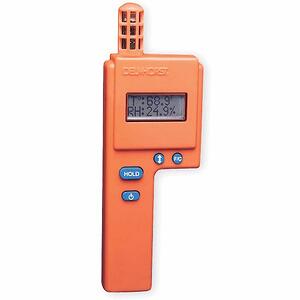For many people who are new to the idea of using moisture meters to monitor the moisture content of different building materials, the terms “moisture content” and “reading scale” might need some explanation. What do these terms mean, and why are they important when using a moisture meter?
What is Moisture Content?
Moisture content (MC) is a reference to the amount of moisture present in a material. This value is often represented as a percentage of the material’s mass (such as X% MC). The amount of moisture in an object can be measured in several different ways, such as with oven-dry tests or moisture meters.
Oven-Dry Testing
Oven-dry tests measure moisture content by weight—a piece of material is weighed and then placed in an oven at a set temperature for as long as it takes for the material to stop changing weight. Once dry, the material is weighed again, and the difference in pre-drying weight and post-drying weight is used to determine how much moisture was in the material being tested.
However, there are a few issues with these tests. First, they can take a while to finish and require an oven of some kind—making them impractical for on-the-go testing moisture.
Second, such tests are frequently destructive to the materials being tested—rendering them unusable in many cases (such as when testing wood or some plants).
Finally, concerns have been raised about the accuracy of such testing—as one CSC Scientific article asks, “Are we certain that other volatiles did not leave with the water or decompose with the heat?” Despite this concern, oven-dry testing is generally accepted to be the most accurate means of measuring moisture content in a wide variety of materials.
Moisture Meter Testing
 The other method for testing the moisture content of different materials is the use of moisture meters. The way that this works will vary slightly depending on the type of moisture meter being used. Moisture meters can be divided into two broad categories:
The other method for testing the moisture content of different materials is the use of moisture meters. The way that this works will vary slightly depending on the type of moisture meter being used. Moisture meters can be divided into two broad categories:
- Pinless Moisture Meters. These meters rely on electromagnetic waves to “scan” a material sample. The contact plate on the meter needs materials with a flat surface and sufficient thickness to operate properly. If the contact plate can’t make solid contact, then the radio wave might become distorted. If the material is too thin, then the pinless meter might scan the material behind the sample being scanned.
- Pin Type Moisture Meters. These meters use the principle of electrical resistance to measure moisture in various building materials. A set of pins are inserted into the material being tested, and an electric current is passed from one pin, and through the material to the other pin. Since water conducts electricity, more resistance means less water, and less resistance means more water.
Reading Scales and Moisture Meters
It is in moisture meter testing that the term “reading scale” becomes important. Why?
Because, with moisture meters, each device is usually calibrated to get accurate (or “quantitative”) readings in one kind of material. For example, there are some moisture meters that are optimized for getting accurate readings in wood. These would be called wood moisture meters and have a “wood reading scale.” On the other hand, there are moisture meters optimized for hay—these meters would be called hay moisture meters and have a hay reading scale.
However, there are other meters, such as soil moisture meters, that are designed to measure the available moisture in soil, but don’t have a “soil reading scale.” The reason for this is that although the meter measures the available moisture in soil, there are too many variables in soil composition in different parts of the world to allow a consistent standard of measurement for the actual moisture content of soil.
Some meters use a “reference scale” mode that isn’t calibrated for any single material. Instead, reference meters provide a qualitative estimate of moisture in a given material. Some professionals use this setting to get a quick pass/fail moisture assessment in materials that don’t have an associated reading scale (or, if the user doesn’t have the right meter for the job).
With reference scale meters, the user typically tests a sample of material they know is dry, and then uses that reading as a comparison (or “reference”) point. If the reading is close to or the same as the “dry” sample, then the material is probably dry, if the reading is significantly higher, then it is most likely wet.
Of course, even within a single reading scale, there is room for variation in the physical properties of the material being tested. For example, there are hundreds of species of wood, each with its own specific gravity and electrical conductivity (the two factors that affect pinless and pin-type moisture meters, respectively). To account for this, some high-quality wood moisture meters have a built-in species correction feature—which is kind of like having a reading scale specialized for a specific type of wood. There is a similar feature used in some grain moisture meters to account for the hundreds of grain crop types farmers commonly grow.
To recap in brief:
- Moisture Content is an assessment of how much moisture is in a material. This information may mean different things depending on the material being tested.
- Reading Scales are an expression of what material (or materials) the moisture meter is calibrated to provide accurate readings in.
Need to know more about how moisture meters work and how to use them? Download our free Moisture Meters 101 guide at the link below. Or contact us to talk about your moisture meter options.

Comments